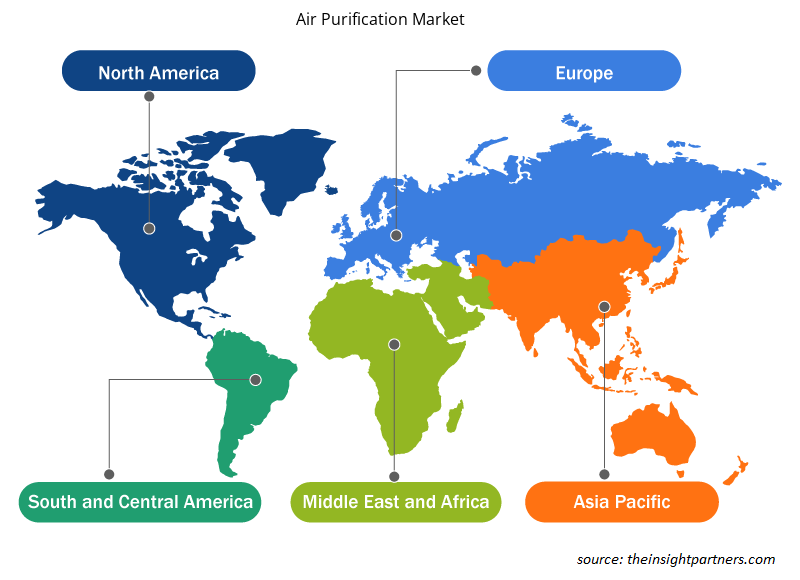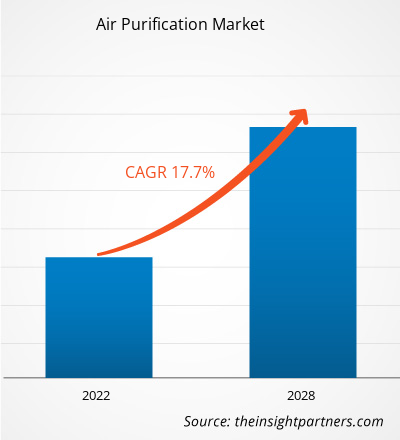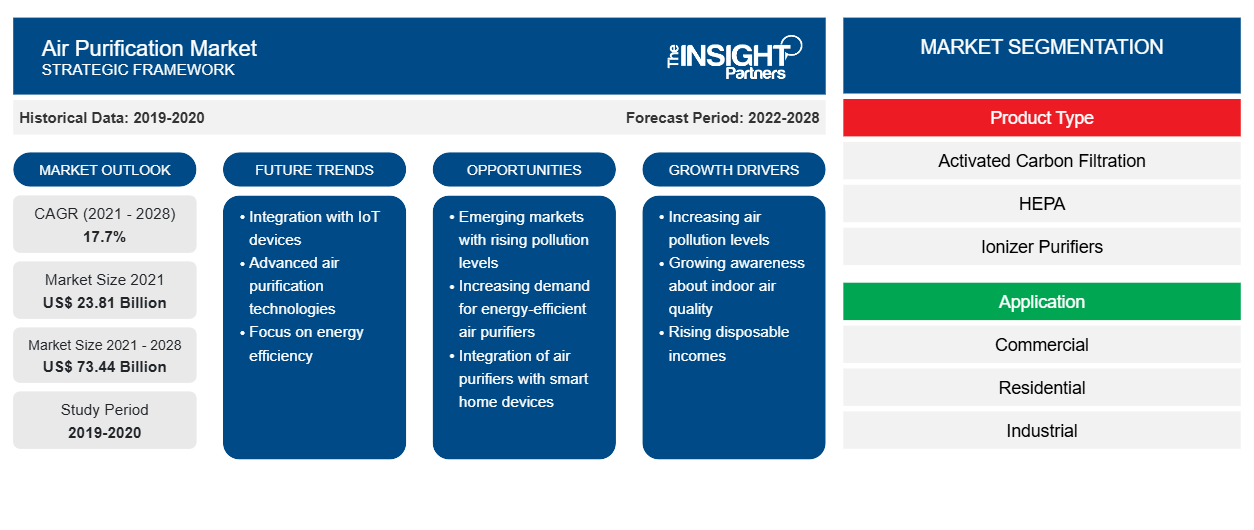Se espera que el mercado de purificación de aire crezca de US$ 23.809,52 millones en 2021 a US$ 73.437,36 millones en 2028. Se estima que crecerá a una CAGR del 17,7% entre 2021 y 2028.
El aumento de las enfermedades transmitidas por el aire debido al aumento de la contaminación atmosférica es un factor clave atribuido al crecimiento del mercado. Además, la creciente concienciación entre los consumidores sobre el uso de purificadores de aire, el aumento de los ingresos disponibles y la mejora del nivel de vida son los factores destacados que impulsan el crecimiento del mercado. La creciente tendencia a la adopción de purificadores de aire portátiles e inteligentes está impulsando aún más la dinámica del mercado durante el período de previsión. Las iniciativas gubernamentales de apoyo relacionadas con las normas de emisión, la aplicación de las normas de salud y seguridad de la fuerza laboral y la modificación de las políticas de pureza del aire existentes fortalecen aún más la dinámica del mercado de purificación del aire . Por ejemplo, en agosto de 2021, la India había planeado restablecer las nuevas normas nacionales de calidad del aire ambiente ( NAAQS ) en 2022.
Las nuevas normas incluyen componentes de partículas ultrafinas, que se sitúan por debajo de PM2,5 en presencia de más contaminantes. Además, en septiembre de 2021, la Organización Mundial de la Salud (OMS) introdujo nuevas Directrices mundiales de calidad del aire ( GCA ) para proteger la salud de las poblaciones reduciendo los niveles de los principales contaminantes del aire que contribuyen al cambio climático. Por tanto, estas iniciativas aumentan aún más la necesidad de productos de purificación del aire, lo que impulsa las perspectivas del mercado durante el período de previsión.
La demanda mundial de filtros de aire portátiles es una tendencia clave que está proliferando en el mercado. El cambio de estilo de vida afecta directamente a la salud de las personas, lo que aumenta la necesidad de productos de purificación del aire. Los purificadores de aire portátiles emplean un filtro HEPA-13, un filtro de carbón y un revestimiento antimicrobiano en dichos filtros para evitar el crecimiento bacteriano. Estos filtros son bastante efectivos y están de moda en términos de adopción. El aumento del nivel de contaminación y el creciente número de enfermedades transmitidas por el aire han acelerado la demanda de filtros de aire portátiles. El estudio de los investigadores de la Universidad Simon Fraser concluye que tener un purificador de aire portátil en el hogar puede reducir los impactos negativos de la contaminación del aire en el desarrollo cerebral de los niños. Las inversiones en curso en filtros de aire portátiles están ayudando a que el mercado florezca.
El estudio de mercado de purificación de aire se centra principalmente en dos segmentos, a saber, tipo de producto y aplicación. El segmento de tipo de producto se subdivide en filtración de carbón activado, aire particulado de alta eficiencia ( HEPA ), purificadores ionizadores, irradiación germicida ultravioleta ( UVGI ) y otros. El segmento de aplicación se segmenta además en comercial, residencial e industrial. Por geografía, el mercado está segmentado en América del Norte, Europa, Asia Pacífico, Medio Oriente y África, y América del Sur.
Personalice este informe según sus necesidades
Obtendrá personalización en cualquier informe, sin cargo, incluidas partes de este informe o análisis a nivel de país, paquete de datos de Excel, así como también grandes ofertas y descuentos para empresas emergentes y universidades.
-
Obtenga las principales tendencias clave del mercado de este informe.Esta muestra GRATUITA incluirá análisis de datos, desde tendencias del mercado hasta estimaciones y pronósticos.
Impacto de la pandemia de COVID-19 en el mercado de purificación del aire
Dinamarca, Polonia y Francia se encuentran entre los países con altos niveles de contaminación del aire. El medio ambiente se ve afectado positivamente por las regulaciones gubernamentales en varios países europeos con respecto al desarrollo de edificios respetuosos con el medio ambiente en los sectores residencial y comercial. La región es un importante centro industrial y manufacturero para equipos industriales, automoción, construcción, energía y electricidad. Sin embargo, debido a los cierres comerciales , las prohibiciones de viaje y las interrupciones de la cadena de suministro en 2020, algunas de estas industrias han disminuido en la región, lo que ha reducido significativamente la contaminación del aire. Sin embargo, las crecientes preocupaciones sobre la seguridad del SARS-CoV-2 han aumentado la demanda de purificadores de aire .
En 2020, las medidas de confinamiento impuestas por el gobierno obligaron a la gente a quedarse en casa, lo que impulsó las ventas de purificadores de aire para uso residencial. Varios fabricantes internacionales de purificadores de aire ven la pandemia como una oportunidad. Por ejemplo, el gigante surcoreano de purificadores de aire, Coway, se ha expandido a Europa debido a la creciente demanda de purificadores de aire en la región. La empresa se hizo cargo del equipo de integración de Serviceplan y de la unidad de la agencia Plan.Net. Por lo tanto, el aumento de la contaminación del aire y la contaminación causada por virus y bacterias brindan oportunidades de crecimiento para los actores del mercado de purificadores de aire de Europa.
Perspectivas de mercado: mercado de purificación del aire
La creciente urbanización e industrialización están impulsando el crecimiento del mercado
El aumento de la urbanización aumentaría necesariamente la necesidad de productos de filtrado de aire a gran escala en aplicaciones residenciales y comerciales, lo que ayudaría a impulsar el crecimiento del mercado durante el período de pronóstico. Los países de las economías en desarrollo están experimentando predominantemente el aumento de la urbanización a un ritmo más rápido. El aumento de la población también está ayudando a las personas a cambiar hacia la urbanización, lo que ayuda al crecimiento del mercado. Según el Grupo del Banco Mundial, la población urbana mundial aumentará 1,5 veces hasta los 6 mil millones en 2045. Además, según el Foro Económico Mundial, se espera que la población mundial en las ciudades aumente del 55% en 2022 al 80% en 2050. Los países de Asia Pacífico tienen oportunidades sin precedentes para catalizar el desarrollo económico a través de una mayor urbanización en los próximos años. El aumento de los ingresos y la capacidad de gasto de las personas en las economías en desarrollo y la creciente demanda en varios sectores de uso final, como la automoción, la atención sanitaria y médica, la construcción y edificación, la fabricación y la energía y los servicios públicos son los principales factores que impulsan el crecimiento del mercado de la purificación del aire. El aumento de la urbanización incluye la expansión de escuelas, universidades, hospitales, complejos comerciales, casas residenciales y otros factores, en los que surge la necesidad de aire limpio, lo que ayuda a impulsar el mercado. El aumento de la urbanización provocó una enorme contaminación del aire interior y exterior, lo que está aumentando aún más la demanda de purificadores de aire.
Información basada en el tipo de producto
Según el tipo de producto, el mercado de purificación de aire se segmenta en filtración de carbón activado, aire particulado de alta eficiencia (HEPA), purificadores ionizadores, irradiación germicida ultravioleta (UVGI) y otros. El segmento HEPA representó la mayor participación de mercado en 2021 debido a la creciente demanda de varias industrias, incluidos los semiconductores y la microelectrónica.
Perspectivas basadas en aplicaciones
Según la aplicación, el mercado de purificación de aire se segmenta en comercial, residencial e industrial. El segmento comercial representó la mayor participación de mercado en 2021.
Perspectivas regionales del mercado de purificación del aire
Los analistas de Insight Partners explicaron en detalle las tendencias y los factores regionales que influyen en el mercado de purificación del aire durante el período de pronóstico. Esta sección también analiza los segmentos y la geografía del mercado de purificación del aire en América del Norte, Europa, Asia Pacífico, Oriente Medio y África, y América del Sur y Central.

- Obtenga datos regionales específicos para el mercado de purificación de aire
Alcance del informe de mercado de purificación de aire
| Atributo del informe | Detalles |
|---|---|
| Tamaño del mercado en 2021 | US$ 23.81 mil millones |
| Tamaño del mercado en 2028 | US$ 73,44 mil millones |
| CAGR global (2021-2028) | 17,7% |
| Datos históricos | 2019-2020 |
| Período de pronóstico | 2022-2028 |
| Segmentos cubiertos |
Por tipo de producto
|
| Regiones y países cubiertos |
América del norte
|
| Líderes del mercado y perfiles de empresas clave |
|
Densidad de actores del mercado de purificación de aire: comprensión de su impacto en la dinámica empresarial
El mercado de purificación de aire está creciendo rápidamente, impulsado por la creciente demanda de los usuarios finales debido a factores como la evolución de las preferencias de los consumidores, los avances tecnológicos y una mayor conciencia de los beneficios del producto. A medida que aumenta la demanda, las empresas amplían sus ofertas, innovan para satisfacer las necesidades de los consumidores y aprovechan las tendencias emergentes, lo que impulsa aún más el crecimiento del mercado.
La densidad de actores del mercado se refiere a la distribución de las empresas o firmas que operan dentro de un mercado o industria en particular. Indica cuántos competidores (actores del mercado) están presentes en un espacio de mercado determinado en relación con su tamaño o valor total de mercado.
Las principales empresas que operan en el mercado de purificación de aire son:
- Corporación Whirlpool
- Camfil
- INDUSTRIAS DAIKIN, Ltd.
- Compañía: Honeywell International Inc.
- Philips NV, la línea Koninklijke
Descargo de responsabilidad : Las empresas enumeradas anteriormente no están clasificadas en ningún orden particular.

- Obtenga una descripción general de los principales actores clave del mercado de purificación de aire
Los actores que operan en el mercado de purificación de aire se centran principalmente en el desarrollo de productos avanzados y eficientes.
- En noviembre de 2019, Philips India, una subsidiaria de Royal Philips, lanzó la serie de purificadores de aire 800 en el mercado indio. Esto llevó a Philips a ofrecer purificadores de aire en varios segmentos de precios.
- En mayo de 2021, Daikin lanzó los purificadores de aire, purificadores de aire portátiles diseñados para mejorar la calidad del aire interior en Oriente Medio y África. La empresa presenta dos modelos: el modelo premium y el modelo económico.
Lista de empresas
- TECNOLOGÍAS ACTIVEPURE LLC
- CORPORACIÓN WHIRLPOOL
- CAMFIL
- INDUSTRIAS DAIKIN, LTD.
- HONEYWELL INTERNACIONAL, INC.
- IQAIR AMÉRICA DEL NORTE, INC.
- CONFIANZA PHILIPS NV
- LG ELECTRÓNICA, INC.
- CORPORACIÓN PANASONIC
- Compañía: UNILEVER PLC.
- Análisis histórico (2 años), año base, pronóstico (7 años) con CAGR
- Análisis PEST y FODA
- Tamaño del mercado, valor/volumen: global, regional y nacional
- Industria y panorama competitivo
- Conjunto de datos de Excel
Informes recientes
Testimonios
Razón para comprar
- Toma de decisiones informada
- Comprensión de la dinámica del mercado
- Análisis competitivo
- Información sobre clientes
- Pronósticos del mercado
- Mitigación de riesgos
- Planificación estratégica
- Justificación de la inversión
- Identificación de mercados emergentes
- Mejora de las estrategias de marketing
- Impulso de la eficiencia operativa
- Alineación con las tendencias regulatorias























 Obtenga una muestra gratuita para - Mercado de purificación de aire
Obtenga una muestra gratuita para - Mercado de purificación de aire